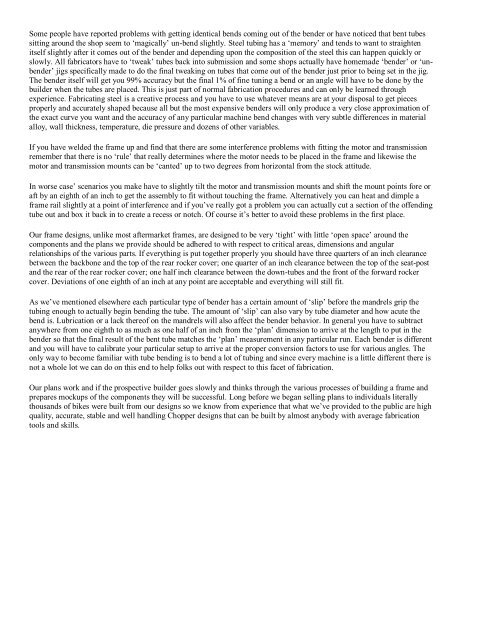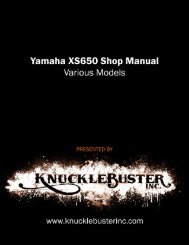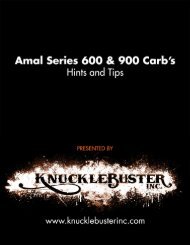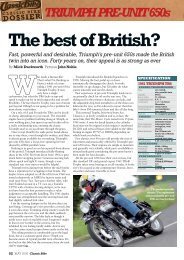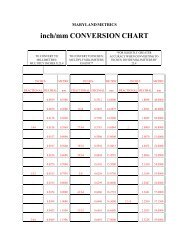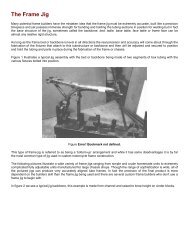Old School Chopper Frame Fabrication - Knucklebuster
Old School Chopper Frame Fabrication - Knucklebuster
Old School Chopper Frame Fabrication - Knucklebuster
Create successful ePaper yourself
Turn your PDF publications into a flip-book with our unique Google optimized e-Paper software.
Some people have reported problems with getting identical bends coming out of the bender or have noticed that bent tubes<br />
sitting around the shop seem to ‘magically’ un-bend slightly. Steel tubing has a ‘memory’ and tends to want to straighten<br />
itself slightly after it comes out of the bender and depending upon the composition of the steel this can happen quickly or<br />
slowly. All fabricators have to ‘tweak’ tubes back into submission and some shops actually have homemade ‘bender’ or ‘unbender’<br />
jigs specifically made to do the final tweaking on tubes that come out of the bender just prior to being set in the jig.<br />
The bender itself will get you 99% accuracy but the final 1% of fine tuning a bend or an angle will have to be done by the<br />
builder when the tubes are placed. This is just part of normal fabrication procedures and can only be learned through<br />
experience. Fabricating steel is a creative process and you have to use whatever means are at your disposal to get pieces<br />
properly and accurately shaped because all but the most expensive benders will only produce a very close approximation of<br />
the exact curve you want and the accuracy of any particular machine bend changes with very subtle differences in material<br />
alloy, wall thickness, temperature, die pressure and dozens of other variables.<br />
If you have welded the frame up and find that there are some interference problems with fitting the motor and transmission<br />
remember that there is no ‘rule’ that really determines where the motor needs to be placed in the frame and likewise the<br />
motor and transmission mounts can be ‘canted’ up to two degrees from horizontal from the stock attitude.<br />
In worse case’ scenarios you make have to slightly tilt the motor and transmission mounts and shift the mount points fore or<br />
aft by an eighth of an inch to get the assembly to fit without touching the frame. Alternatively you can heat and dimple a<br />
frame rail slightly at a point of interference and if you’ve really got a problem you can actually cut a section of the offending<br />
tube out and box it back in to create a recess or notch. Of course it’s better to avoid these problems in the first place.<br />
Our frame designs, unlike most aftermarket frames, are designed to be very ‘tight’ with little ‘open space’ around the<br />
components and the plans we provide should be adhered to with respect to critical areas, dimensions and angular<br />
relationships of the various parts. If everything is put together properly you should have three quarters of an inch clearance<br />
between the backbone and the top of the rear rocker cover; one quarter of an inch clearance between the top of the seat-post<br />
and the rear of the rear rocker cover; one half inch clearance between the down-tubes and the front of the forward rocker<br />
cover. Deviations of one eighth of an inch at any point are acceptable and everything will still fit.<br />
As we’ve mentioned elsewhere each particular type of bender has a certain amount of ‘slip’ before the mandrels grip the<br />
tubing enough to actually begin bending the tube. The amount of ‘slip’ can also vary by tube diameter and how acute the<br />
bend is. Lubrication or a lack thereof on the mandrels will also affect the bender behavior. In general you have to subtract<br />
anywhere from one eighth to as much as one half of an inch from the ‘plan’ dimension to arrive at the length to put in the<br />
bender so that the final result of the bent tube matches the ‘plan’ measurement in any particular run. Each bender is different<br />
and you will have to calibrate your particular setup to arrive at the proper conversion factors to use for various angles. The<br />
only way to become familiar with tube bending is to bend a lot of tubing and since every machine is a little different there is<br />
not a whole lot we can do on this end to help folks out with respect to this facet of fabrication.<br />
Our plans work and if the prospective builder goes slowly and thinks through the various processes of building a frame and<br />
prepares mockups of the components they will be successful. Long before we began selling plans to individuals literally<br />
thousands of bikes were built from our designs so we know from experience that what we’ve provided to the public are high<br />
quality, accurate, stable and well handling <strong>Chopper</strong> designs that can be built by almost anybody with average fabrication<br />
tools and skills.


